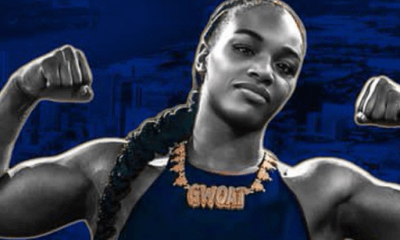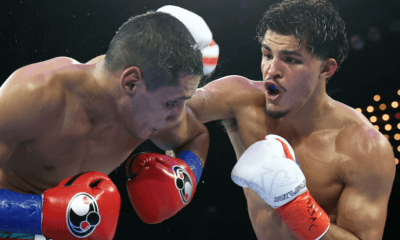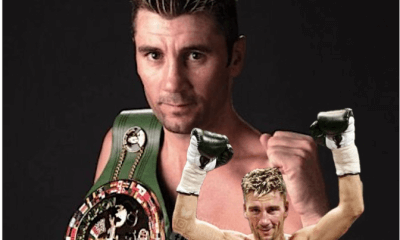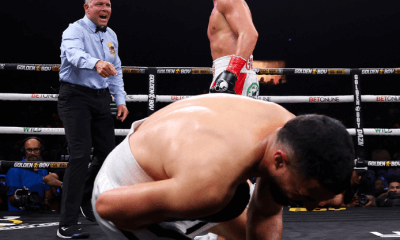Featured Articles
Spared Prison by a Lenient Judge, Chordale Booker Pursues a World Boxing Title
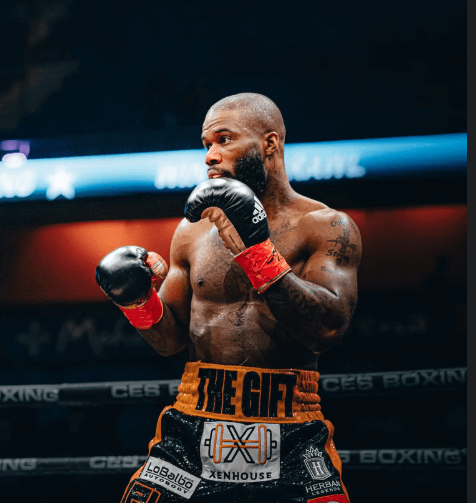
Spared Prison by a Lenient Judge, Chordale Booker Pursues a World Boxing Title
“I always wanted to be great. Not great like Muhammad Ali; just great in my community. If little kids followed behind me every time I went out running, that would be the summit.”
The speaker is Chordale Booker and when he talks about his community, one gets the sense that he is talking about the entire city of Stamford, Connecticut, the city that hued him.
Chordale (pronounced Cor-dell) dreams about returning to Stamford next week laureled as a world boxing champion. Standing in his way is Sebastian Fundora who holds the WBC and WBO belts in the 154-pound weight class. Booker, 33, and Fundora, 27, will lock horns Saturday night at Mandalay Bay in Las Vegas in the main event of a PBC show that will air on Amazon Prime Video.
Historically, boxing and poverty have gone hand-in-hand. Chordale Booker spent his formative years on the west side of Stamford, home to one of America’s most notorious public housing projects. Like many of his peers, he seemed destined to spend a portion of his adult life in prison.
Booker, by his own admission, was selling weed when still in middle school and picking up some extra pocket change while serving as a lookout for dealers higher-up in the food chain. He was in his late teens when police intercepted a potential gang fight and found drugs and a handgun in his car. “Some of the drugs were mine,” Booker acknowledges, “but not all of them. I was the only one arrested, but I couldn’t snitch on my friends.”
He could have been sent to prison for 13 years if District Superior Court judge Gary White adhered to mandatory sentencing guidelines, but White was lenient and let him off with three-years’ probation.
Given a reprieve, as it were, Booker reassessed his life and decided to dedicate himself to the sport of boxing and to healing some of the divisions in his community. The nickname that he wears on his boxing shorts, “The Gift,” honors Judge White’s benevolence.
Booker was living with an aunt and uncle in the Flatbush section of Brooklyn during the bulk of his amateur career. A frequent sparring partner who became one of his best friends was Patrick Day. Chordale spent many hours at the PAL gym in Freeport, Long Island, where Day trained under the tutelage of his Freeport neighbor Joe Higgins, a retired Brooklyn firefighter.
On Oct. 16, 2019, Patrick Day died at Chicago’s Northwestern Memorial Hospital from a traumatic brain injury four days after being knocked out by former U.S. Olympian Charles Conwell.
Conwell, overcome with grief, nearly quit boxing, but was encouraged to keep fighting and soldiered on. Undefeated (21-0) as a pro, he’s ranked #3 by the WBC and #2 by the WBO at 154 which puts him near the top of the queue in the race to fight the winner of Fundora-Booker.
At the elite level, amateur boxing is a small world. Chordale Booker lost two decisions to Charles Conwell in 2015, the second a razor-thin decision in late December at the Olympic Trials in Reno. But as to meeting up with Conwell again down the road, Booker is understandably conflicted. “I would love to win back that loss to him in the Trials, but emotionally it would be tough because I can’t think about him without also thinking of Patrick. Of course, this is nothing personal.”
Chordale Booker is the subject of a prize-winning 16-minute documentary by Craig Cutler that was released in 2016 shortly after the boxer turned pro. In the film, which can be found online, Chordale talks about how boxing and the sacrifices it commands gave purpose to his life. He also waxes poetically on boxing as an art form: “The magnificent boxers are the ones that see the art. They know how to move and flow with the rhythm of a fight. When I am fighting, my goal is to disrupt [my opponent’s] rhythm. It sounds simple, but it takes hours of practice to perfect that.”
Booker won his first 17 pro fights preceding his date with Austin “Ammo” Williams on the undercard of the historic first fight between Katie Taylor and Amanda Serrano at Madison Square Garden. “I don’t want to make excuses, but he caught me at the right time in my career. I had a lot of issues in my life and I couldn’t turn down the money.”
That was a humbling experience made more demoralizing by the venue. As an amateur, Chordale thirsted to fight at Madison Square Garden but never did get to fight at the storied sock palace despite winning a slew of local tourneys – a highlight was winning the Sugar Ray Robinson Trophy as the best open division boxer at the 2015 Golden Gloves tournament – but by then the sponsor of the longstanding annual event, the New York Daily News, had shifted the tourney from the Garden to Barclays Center.
Booker has won six fights since that mishap at MSG, five on cards with modest purses in his home state at the Mohegan Sun Casino in Uncasville, elevating his record to 23-1 (11 KOs).
Sebastian Fundora, one-half of the first brother-sister combination to hold world titles simultaneously, is a puzzle for any opponent. At six-foot-six, he is the tallest title-holder ever in his weight class. Per boxrec, he will have a nine-inch height and 10-inch reach advantage. It’s a pairing that would lead an old-time scribe to dust off the adjective “Mutt-and-Jeff.”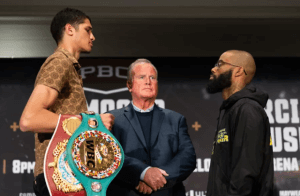
In the online marketplace, the odds favoring Fundora (21-1-1, 15 KOs) are as high as 14/1. While one can see the logic, it’s a physical mismatch, one can reasonably question whether the “Towering Inferno” should be a 14/1 favorite over anyone. He’s led a rather charmed life since getting bombed out in the seventh round by Brian Mendoza in a fight that he, Fundora, was winning handily.
Fundora’s next and most recent fight, against Tim Tszyu, came about when Tszyu’s original opponent Keith Thurman was a late scratch with a biceps injury. Fundora, who was already on the card, paired against Serhii Bohachuk, was bumped into the main event and rose to the occasion, upsetting the Australian by a split, but fair, decision. There was, however, an extenuating circumstance. In round two, Tszyu ducked low and ran into Fundora’s bony elbow which opened a deep cut on his hairline that bled copiously throughout the bout.
Considering how Tim Tszyu was manhandled by Bakhram Murtazaliev, one could argue that Thurman’s injury, and the rejiggering it provoked, was fortuitous for Sebastian Fundora who found himself thrust against a less formidable opponent.
Regardless of whether Booker returns to Stamford as a world title-holder or a former world title challenger, he will always be a champion at the Revolution Training fitness center on Elmcroft Road where Chordale hangs his hat, practicing his craft and mentoring at-risk youth 8-to-18 in his “Go The Distance” program. Judge Gary White’s instincts were pretty good. Spared from prison, Chordale Booker has become a rock of the community.
To comment on this story in the fight Forum CLICK HERE
-

 Featured Articles3 weeks ago
Featured Articles3 weeks agoResults and Recaps from New York Where Taylor Edged Serrano Once Again
-

 Featured Articles3 days ago
Featured Articles3 days agoThe Hauser Report: Zayas-Garcia, Pacquiao, Usyk, and the NYSAC
-

 Featured Articles2 weeks ago
Featured Articles2 weeks agoResults and Recaps from NYC where Hamzah Sheeraz was Spectacular
-

 Featured Articles3 weeks ago
Featured Articles3 weeks agoFrom a Sympathetic Figure to a Pariah: The Travails of Julio Cesar Chavez Jr
-

 Featured Articles3 weeks ago
Featured Articles3 weeks agoPhiladelphia Welterweight Gil Turner, a Phenom, Now Rests in an Unmarked Grave
-

 Featured Articles1 week ago
Featured Articles1 week agoManny Pacquiao and Mario Barrios Fight to a Draw; Fundora stops Tim Tszyu
-

 Featured Articles1 week ago
Featured Articles1 week agoArne’s Almanac: Pacquiao-Barrios Redux
-

 Featured Articles4 weeks ago
Featured Articles4 weeks agoCatterall vs Eubank Ends Prematurely; Catterall Wins a Technical Decision




